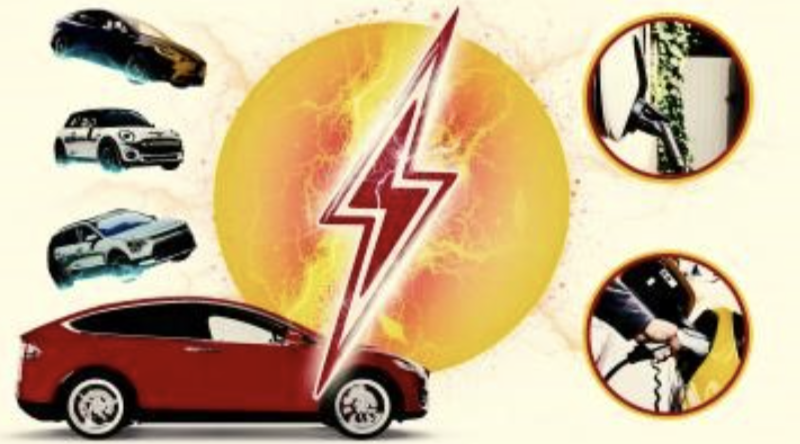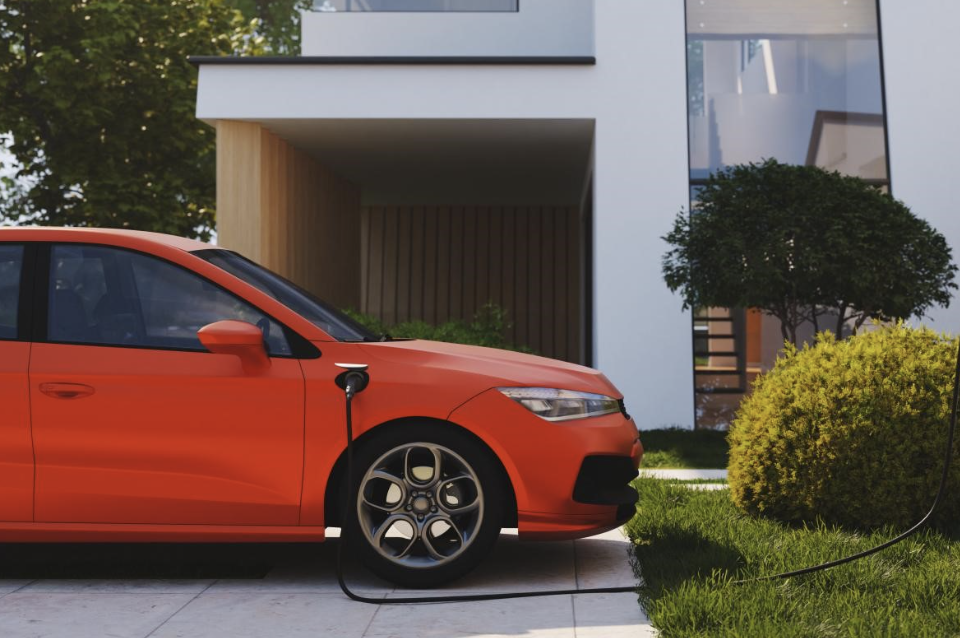Where’s my nearest electric car charger? The reality of owning an EV
Go backPublished in The Sunday Times 6th August 2023

Chargers are spread unevenly around the country. Use our interactive map to find out what’s happening in your area
Amanda Irwin, 42, an NHS consultant psychiatrist, and her husband, Ben, a criminal barrister, are among 840,000 people who own electric cars — a sharp rise compared to just over 97,500 who had them back in 2019.
They love the idea of their Audi e-tron, which they got two years ago. However, the chronic shortage of public chargers — with an average of 18 electric vehicles per public charging station — has meant that using it has become almost impossible for long-distance journeys.
Amanda and Ben are passionate about wanting to do the right thing for the environment — they have even installed a biomass wood pellet boiler at their £1.75 million eco-home in Hunton, near Maidstone, Kent.

Amanda and Ben’s home in Hunton, near Maidstone, Kent
And having a charger installed outside their six-bedroom grade II listed house was crucial, allowing them to charge the car overnight. Plugging it into a conventional socket would have taken three full days.
It was also a bonus that the cost of installing the charger was covered by Amanda’s work salary sacrifice scheme, under which she also got the car.
However, Amanda and Ben think the paucity of the public charger network is, ultimately, failing them and other electric car users — at exactly the time when they believe it ought to be better incentivised, with petrol and diesel drivers facing clampdowns such as the Ulez extension in nearby London.
The Irwins’ car has a range of 180 miles and, such is the anxiety and hassle involved in finding somewhere to charge, Amanda tries to avoid long-distance journeys.
“I took the car to West Sussex recently and I wanted to top up the charge, and I had to go to three different places,” she says.
“People were queueing to use the fast public chargers. So I had to wait for two or three hours with small children to get to the chargers and then it would take another couple of hours to top it up, so the infrastructure is still limited.
“Recently I was at Cobham service station [in Surrey on the M25 motorway] and it was absolutely packed. They only had six EV chargers, which were all full. I’ve heard people asking the person in front if they wouldn’t mind just doing a bit of a charge — not the whole lot — so that they could have a go or they’d be late for their meetings.”

The Irwin family are passionate about the environment
As a result, when the family go on substantial holidays, particularly overseas, Amanda says she doesn’t take the electric car but takes their diesel vehicle instead. “It’s such a long journey that to add on hours for all the electric charging would be really difficult with the children in the car.”
The explosion of electric cars since the pandemic has been extraordinary. Today there are 839,678 battery electric vehicles on the road, according to the EV data company Zapmap — a 861 per cent rise on 2019, when there were only 97,565. One in five of these cars is a Tesla.
What’s more, under a rule to be introduced in January, car makers will be required by the government to ensure that at least 22 per cent of their new sales in the UK are of emission-free models, rising each year to reach 80 per cent by 2030. Companies that break the rule will have to pay £15,000 for every non zero-emission car sold.
However, the evidence suggests that the number of public chargers is not keeping pace with the rising rate of ownership. Official figures show there are only 45,737 public charging points nationwide, scattered between petrol stations, motorway service stations and shopping centres — and the government is set to miss its target of 300,000 by 2030, according to an analysis by the electric car reviews site Electrifying.com. The spread is also wildly inconsistent across the country.
Plus, experts believe any further significant progress in the electric car rollout could be put in danger of failing because it remains extremely difficult — both logistically and legally — for households to install charger points on their homes if they do not have driveways. Savills research finds that, partly because of this, ownership of electric cars continues to intensify in the most affluent areas and decline elsewhere. Here’s what you need to know.
Where to find a public charger
Electrifying.com calculates that more than 3,300 chargers will need to be installed each month until 2030 for the magic number of 300,000 by 2030 to be reached — but this is three times the number currently being put in. Although, in February, Huw Merriman, the transport minister, maintained that the government remained on track to meet the target.
As well as a lack of chargers, Department for Transport (DfT) figures released last week show wild differences in public charger provision around the country.
It showed that 30 per cent of UK public chargers of all speeds are in the Greater London area, with Westminster alone boasting 2,158. This is almost double the number of chargers in Birmingham (472), Leeds (514) and Manchester (188) combined.
Broken down, the DfT figures show there are only 39 public chargers per 100,000 population in the northwest, while in Greater Manchester there are 27. Meanwhile in Hertfordshire there are 67 and in London there are 152, with this rising to 243 in inner London.
“We need to ensure we get chargers at the right speeds into the right locations. At the moment our major cities outside of London are falling significantly behind,” Ginny Buckley, the founder of Electrifying.com, says. “This simply can’t continue, if we’re to bring everyone along on the journey, particularly as we know how critical the public network is for those large numbers of drivers who can’t charge at home.”
When you’re looking for a public charger, you should be aware that their speeds vary greatly. Charging devices can be categorised as slow, fast, rapid or ultra-rapid, with the largest number of these (25,239) being fast. Chargers of all kinds can be found on the street (usually in residential areas), en route (in places like service stations, petrol forecourts, ferry terminals or hotels) and at destinations (such as retail car parks, car parks, leisure and education areas, restaurants and hotels). In addition, fast and slow devices can be located at restricted-access areas like workplaces.
The type of charger makes a huge difference: slow charging to get a battery to 80 per cent can take several hours while the most rapid chargers can do so in 30 minutes.
The costs vary too. Charging at home typically costs £17 for a full charge, while many public charge points at places like supermarkets will be free. However, rapid motorway ones will typically cost about £22 for a 30-minute charge.
Because of these complexities, it’s important to install an app on your phone, such as that provided by Zapmap, which shows where every charger is, by type, across the country.

Home chargers tend to only be suitable for people with driveways
How to charge from home
A key reason we may be close to hitting a glass ceiling on electric car rollout is because home chargers really only make sense for people with driveways, with a few notable exceptions.
Those living in terraced houses or flats with no driveway, for example, face having to drag cables across pavements. If not done carefully this could land you in legal trouble, because running a cable from your house to your car is technically illegal in many local authority areas, and some EV insurance policies now offer warnings that other people tripping over your cable could trigger legal action.
“Motorists who can’t charge at home are over five times less likely to switch to electric cars,” says Joel McTeague, chief executive of Co Charger, an electric vehicle charger sharing app. “There is a fundamental problem in how we view EV charging and we must address it.”
Add to this the fact that public charger provision is so much better in the south, it’s little surprise that the top ten areas with the highest proportion of electric cars are in the most prosperous areas of London and the southeast, according to analysis by Savills. Its figures show Westminster — average house price £1.7 million — has the highest percentage of electric cars in the UK, at 4.7 per cent of all vehicles. This is followed by Camden (4.5 per cent of all cars, average house price £1.2 million).
At the other end of the scale, the bottom ten consists entirely of remote areas in Wales, the North of England and Northern Ireland, which have poor charging infrastructure, with Fermanagh and Omagh (0.16 per cent of the total, average property price £158,000) at the bottom of the table.
Savills also found that, after years of growth in electric car ownership during the Covid-19 pandemic, it is now slowing significantly overall, dipping to a 60 per cent rise year-on-year by the third quarter of last year, down from almost 120 per cent in the first quarter of 2021 — perhaps an indication that the glass ceiling will soon be hit, because of the issue with public chargers and a lack of access for private ones.
“We need to give significant thought to how we can incentivise, and help, those who do not live in homes with driveways to get EVs,” Lucian Cook, director of residential research at Savills, says.
Having a charger at home can also increase your house price, although few reliable studies have shown precisely by how much. According to an estimate by the National Association of Property Buyers (NAPB), it will do so by between £3,000 and £5,000.
If you live in one of the 15 million (43 per cent of) homes that do not have a driveway and don’t want to rely on motorway service stations or petrol stations, then you could charge at your workplace or at kerbside and lamppost chargers, which are public chargers specifically designed and located for use by nearby residents. And, even though you can’t drag wires around your street, you could use home-connected on-street charging if you have access to a gully (which is becoming increasingly common), a gantry or even buried cables with plug-in adapters.
You could also join one of a growing number of co-charger sharing schemes, where people use each other’s facilities, including driveways. Co Charger, one of the largest networks, has amassed more than 7,000 users and 2,600 charging points on its database since its launch in November 2020.
Homes with electric chargers as standard
If you’re moving into a new-build property, a growing number of developers are installing electric chargers as standard (this means you can’t opt out), which means that access is being improved for flat-owners who want to drive an EV.
These include developments at Waterbeach, a new town by the developer Urban&Civic on a former barracks and airfield near Cambridge. Other new-builds with charger points include Yellow Fields by Bellway in Wantage, Poppy Fields by Bellway in Oxfordshire and the Wardian development in Canary Wharf.
How to buy an electric car
On the face of it, electric cars remain much more expensive than petrol ones. The average price of a new electric car is £50,931, according to Savills. Last year the Tesla Model Y (retail price £52,657) was the most popular in the country, with 35,554 registrations, compared to Model 3 (19,083 registrations, £50,657), Kia Niro (11,189 registrations, £37,295), Volkswagen ID.3 (9,825 registrations, £39,993) and Nissan Leaf (9,207 registrations, £31,970).
However, very few buyers purchase their cars outright, with the majority paying through PCP finance deals or PCH leasing ones.
One cheap way of buying an electric car is through your workplace salary sacrifice scheme, like the Irwins, which allows you to pay for your car in instalments from your pay before tax is deducted.
Salary sacrifice schemes vary, but your monthly payment usually includes tax, insurance, servicing and breakdown cover. You may already be familiar with other salary sacrifice schemes, such as the cycle-to-work initiative, pension contributions or childcare vouchers, which a growing number of companies offer.
Powered-up homes for sale

Dorset, £2.25 million
Recently renovated Overton House in Lyme Regis is a seven-bedroom property with views of the coast. The double garage has an EV charging point. struttandparker.com

Derbyshire, £1.375 million
A five-bedroom home with a cottage and a modern barn that houses an EV charger. Ashbourne is a 12-minute drive away. fishergerman. co.uk

Kent, from £655,000
Orchard Yard in Wingham village has four property styles available, from two to three bedrooms. Parking includes wiring for a separate EV charger. orchardyard. co.uk
For more information:
01491 821170
property@cognatum.co.uk / www.cognatum.co.uk/properties-for-sale/
Cognatum, a not-for-profit company, has 60 retirement estates in 21 counties across central and southern England, a total of 928 retirement homes. All are in prime locations within vibrant market towns or villages, within walking distance of shops and restaurants. Each estate benefits from thoughtful architecture, landscaped grounds, and a dedicated estate manager.